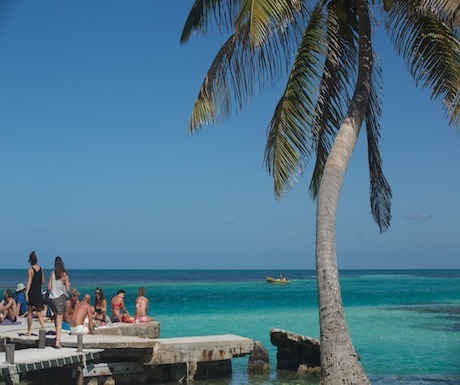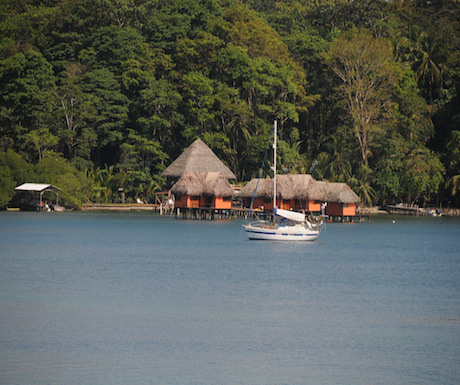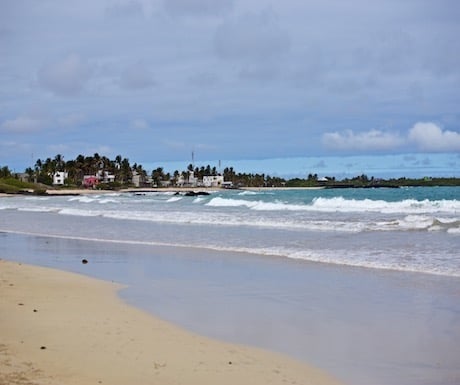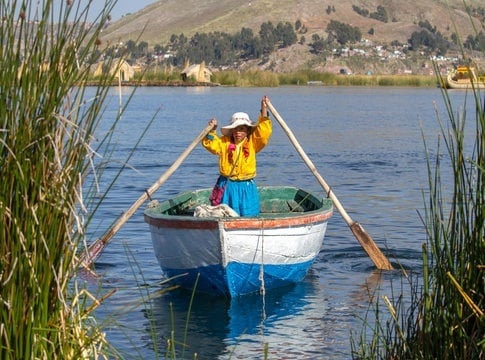Belize · Central America · Ecuador · Panama · Peru · Regions · South America
The top 4 islands to visit in Latin America
To find the real hidden jewels of Central and South America, take to the ocean and seek out the islands. As youll see from the following list, islands are often home to the most interesting and rare environments in a country. These semi-isolated destinations are the best place to snorkel, swim, and test the waters at some of the wildest beaches in the world.
Caye Caulker, Belize
Caye Caulker is one of a small cluster of islands off the coast of northern Belize. These islands are referred to as cayes, pronounced keys. Caye Caulker stands out from the other Belizean islands for its supremely laid-back attitude. You wont find a dress code anywhere on the island, and many businesses dont mind if their patrons go barefoot.
 Caye Caulkers most popular beach is the Split, a beach formed by an inlet that divides the northern and southern sides of the island. The water here is calm and clear the nearby barrier reef blocks waves from reaching the shore. Soak up this beach with a couple of afternoons of swimming and snorkeling. Nearby youll find beachfront bars serving fruity cocktails and Belikin, Belizes national beer of choice.
On the north side of the island, pay a visit to the Caye Caulker Forest Reserve, home to a forest of rare red and black mangrove trees. Mangrove trees have roots that grow in saltwater. They serve as the habitat for rare species of birds, including the elusive mangrove warbler.
From the eastern shore of Caye Caulker, the Belize Barrier Reef looms in the distance a dark blue shadow that serves as the habitat for gigantic schools of fish and neon-colored sponges. You can visit parts of this reef in the Caye Caulker Marine Reserve, which is the premier destination for scuba diving and snorkeling in Belize.
Bastimentos, Panama
Bastimentos Island is part of the Panamanian island chain called Bocas del Toro. A large portion of this island is taken up by the Bastimentos Island National Marine Park, which provides visitors with 32,682 acres (13,226 ha) of wildlife to explore. This park is a habitat for monkeys, sloths, and thousands of species of amphibians and insects.
Caye Caulkers most popular beach is the Split, a beach formed by an inlet that divides the northern and southern sides of the island. The water here is calm and clear the nearby barrier reef blocks waves from reaching the shore. Soak up this beach with a couple of afternoons of swimming and snorkeling. Nearby youll find beachfront bars serving fruity cocktails and Belikin, Belizes national beer of choice.
On the north side of the island, pay a visit to the Caye Caulker Forest Reserve, home to a forest of rare red and black mangrove trees. Mangrove trees have roots that grow in saltwater. They serve as the habitat for rare species of birds, including the elusive mangrove warbler.
From the eastern shore of Caye Caulker, the Belize Barrier Reef looms in the distance a dark blue shadow that serves as the habitat for gigantic schools of fish and neon-colored sponges. You can visit parts of this reef in the Caye Caulker Marine Reserve, which is the premier destination for scuba diving and snorkeling in Belize.
Bastimentos, Panama
Bastimentos Island is part of the Panamanian island chain called Bocas del Toro. A large portion of this island is taken up by the Bastimentos Island National Marine Park, which provides visitors with 32,682 acres (13,226 ha) of wildlife to explore. This park is a habitat for monkeys, sloths, and thousands of species of amphibians and insects.
 The Bastimentos Island National Marine Park has several beaches that are worth visiting. Red Frog Beach takes its name from the bright red frogs that inhabit the surrounding landscape. These frogs are poisonous, but they wont bother you if you dont bother them. Visitors come here for the snorkeling and the clear, bright blue water.
You can stay at beautiful eco-lodges on the edge of the reserve, or book luxury accommodations right next to Red Frog Beach.
Isabela Island, Ecuador
Isabela Island is a popular stop on many cruises to the Galápagos Islands. This island has some of the most sought-after diving and snorkeling destinations in the Galápagos, including Urbina Bay and Punta Vicente Roca. These sites are known for their incredible marine biodiversity, and offer the opportunity to swim near whales, dolphins, and sea lions.
The Bastimentos Island National Marine Park has several beaches that are worth visiting. Red Frog Beach takes its name from the bright red frogs that inhabit the surrounding landscape. These frogs are poisonous, but they wont bother you if you dont bother them. Visitors come here for the snorkeling and the clear, bright blue water.
You can stay at beautiful eco-lodges on the edge of the reserve, or book luxury accommodations right next to Red Frog Beach.
Isabela Island, Ecuador
Isabela Island is a popular stop on many cruises to the Galápagos Islands. This island has some of the most sought-after diving and snorkeling destinations in the Galápagos, including Urbina Bay and Punta Vicente Roca. These sites are known for their incredible marine biodiversity, and offer the opportunity to swim near whales, dolphins, and sea lions.
 Isabela Island is the largest island in the Galápagos, and has more wild Galápagos tortoises than any other island in the archipelago. On the southern end of Isabela you can visit the Tortoise Breeding Center, which is spearheading the effort to rebuild this endangered population. Stop by the center to see baby and adolescent tortoises, as well as adults.
Birders should make a visit to Isabela Island one of their top priorities. This island is the only place in the world you can find Mangrove finches, a species that was very recently on the brink of extinction. Waterfowls like Humboldt penguins, boobies, and cormorants crowd the shores, occasionally diving into the water to hunt for fish.
Uros Floating Islands, Peru
The Uros Floating Islands are a collection of some 40 man-made islands, located on the western side of Lake Titicaca in Peru. These islands are a short ferry ride from the Peruvian town of Puno.
Isabela Island is the largest island in the Galápagos, and has more wild Galápagos tortoises than any other island in the archipelago. On the southern end of Isabela you can visit the Tortoise Breeding Center, which is spearheading the effort to rebuild this endangered population. Stop by the center to see baby and adolescent tortoises, as well as adults.
Birders should make a visit to Isabela Island one of their top priorities. This island is the only place in the world you can find Mangrove finches, a species that was very recently on the brink of extinction. Waterfowls like Humboldt penguins, boobies, and cormorants crowd the shores, occasionally diving into the water to hunt for fish.
Uros Floating Islands, Peru
The Uros Floating Islands are a collection of some 40 man-made islands, located on the western side of Lake Titicaca in Peru. These islands are a short ferry ride from the Peruvian town of Puno.
 These islands are home to the Uros people. The Uros make the islands by weaving together the totora reeds that grow from the bottom of the lake. According to local legend, the Uros built the islands to escape the marauding Inca.
The Uros people dont limit themselves to weaving islands. People who live here wear traditional clothing that they make from brightly colored cloth. They also fashion small boats out of the same reeds they use to make the islands. You can commission one of these boats to take you on a tour of the surrounding islands.
There arent hotels on the Uros islands, but you can stay at one of the hotels on the banks of Lake Titicaca in Puno.
Zach Smith is CEO of Anywhere.
If you would like to be a guest blogger on A Luxury Travel Blog in order to raise your profile, please contact us.
These islands are home to the Uros people. The Uros make the islands by weaving together the totora reeds that grow from the bottom of the lake. According to local legend, the Uros built the islands to escape the marauding Inca.
The Uros people dont limit themselves to weaving islands. People who live here wear traditional clothing that they make from brightly colored cloth. They also fashion small boats out of the same reeds they use to make the islands. You can commission one of these boats to take you on a tour of the surrounding islands.
There arent hotels on the Uros islands, but you can stay at one of the hotels on the banks of Lake Titicaca in Puno.
Zach Smith is CEO of Anywhere.
If you would like to be a guest blogger on A Luxury Travel Blog in order to raise your profile, please contact us.
 Caye Caulkers most popular beach is the Split, a beach formed by an inlet that divides the northern and southern sides of the island. The water here is calm and clear the nearby barrier reef blocks waves from reaching the shore. Soak up this beach with a couple of afternoons of swimming and snorkeling. Nearby youll find beachfront bars serving fruity cocktails and Belikin, Belizes national beer of choice.
On the north side of the island, pay a visit to the Caye Caulker Forest Reserve, home to a forest of rare red and black mangrove trees. Mangrove trees have roots that grow in saltwater. They serve as the habitat for rare species of birds, including the elusive mangrove warbler.
From the eastern shore of Caye Caulker, the Belize Barrier Reef looms in the distance a dark blue shadow that serves as the habitat for gigantic schools of fish and neon-colored sponges. You can visit parts of this reef in the Caye Caulker Marine Reserve, which is the premier destination for scuba diving and snorkeling in Belize.
Bastimentos, Panama
Bastimentos Island is part of the Panamanian island chain called Bocas del Toro. A large portion of this island is taken up by the Bastimentos Island National Marine Park, which provides visitors with 32,682 acres (13,226 ha) of wildlife to explore. This park is a habitat for monkeys, sloths, and thousands of species of amphibians and insects.
Caye Caulkers most popular beach is the Split, a beach formed by an inlet that divides the northern and southern sides of the island. The water here is calm and clear the nearby barrier reef blocks waves from reaching the shore. Soak up this beach with a couple of afternoons of swimming and snorkeling. Nearby youll find beachfront bars serving fruity cocktails and Belikin, Belizes national beer of choice.
On the north side of the island, pay a visit to the Caye Caulker Forest Reserve, home to a forest of rare red and black mangrove trees. Mangrove trees have roots that grow in saltwater. They serve as the habitat for rare species of birds, including the elusive mangrove warbler.
From the eastern shore of Caye Caulker, the Belize Barrier Reef looms in the distance a dark blue shadow that serves as the habitat for gigantic schools of fish and neon-colored sponges. You can visit parts of this reef in the Caye Caulker Marine Reserve, which is the premier destination for scuba diving and snorkeling in Belize.
Bastimentos, Panama
Bastimentos Island is part of the Panamanian island chain called Bocas del Toro. A large portion of this island is taken up by the Bastimentos Island National Marine Park, which provides visitors with 32,682 acres (13,226 ha) of wildlife to explore. This park is a habitat for monkeys, sloths, and thousands of species of amphibians and insects.
 The Bastimentos Island National Marine Park has several beaches that are worth visiting. Red Frog Beach takes its name from the bright red frogs that inhabit the surrounding landscape. These frogs are poisonous, but they wont bother you if you dont bother them. Visitors come here for the snorkeling and the clear, bright blue water.
You can stay at beautiful eco-lodges on the edge of the reserve, or book luxury accommodations right next to Red Frog Beach.
Isabela Island, Ecuador
Isabela Island is a popular stop on many cruises to the Galápagos Islands. This island has some of the most sought-after diving and snorkeling destinations in the Galápagos, including Urbina Bay and Punta Vicente Roca. These sites are known for their incredible marine biodiversity, and offer the opportunity to swim near whales, dolphins, and sea lions.
The Bastimentos Island National Marine Park has several beaches that are worth visiting. Red Frog Beach takes its name from the bright red frogs that inhabit the surrounding landscape. These frogs are poisonous, but they wont bother you if you dont bother them. Visitors come here for the snorkeling and the clear, bright blue water.
You can stay at beautiful eco-lodges on the edge of the reserve, or book luxury accommodations right next to Red Frog Beach.
Isabela Island, Ecuador
Isabela Island is a popular stop on many cruises to the Galápagos Islands. This island has some of the most sought-after diving and snorkeling destinations in the Galápagos, including Urbina Bay and Punta Vicente Roca. These sites are known for their incredible marine biodiversity, and offer the opportunity to swim near whales, dolphins, and sea lions.
 Isabela Island is the largest island in the Galápagos, and has more wild Galápagos tortoises than any other island in the archipelago. On the southern end of Isabela you can visit the Tortoise Breeding Center, which is spearheading the effort to rebuild this endangered population. Stop by the center to see baby and adolescent tortoises, as well as adults.
Birders should make a visit to Isabela Island one of their top priorities. This island is the only place in the world you can find Mangrove finches, a species that was very recently on the brink of extinction. Waterfowls like Humboldt penguins, boobies, and cormorants crowd the shores, occasionally diving into the water to hunt for fish.
Uros Floating Islands, Peru
The Uros Floating Islands are a collection of some 40 man-made islands, located on the western side of Lake Titicaca in Peru. These islands are a short ferry ride from the Peruvian town of Puno.
Isabela Island is the largest island in the Galápagos, and has more wild Galápagos tortoises than any other island in the archipelago. On the southern end of Isabela you can visit the Tortoise Breeding Center, which is spearheading the effort to rebuild this endangered population. Stop by the center to see baby and adolescent tortoises, as well as adults.
Birders should make a visit to Isabela Island one of their top priorities. This island is the only place in the world you can find Mangrove finches, a species that was very recently on the brink of extinction. Waterfowls like Humboldt penguins, boobies, and cormorants crowd the shores, occasionally diving into the water to hunt for fish.
Uros Floating Islands, Peru
The Uros Floating Islands are a collection of some 40 man-made islands, located on the western side of Lake Titicaca in Peru. These islands are a short ferry ride from the Peruvian town of Puno.
 These islands are home to the Uros people. The Uros make the islands by weaving together the totora reeds that grow from the bottom of the lake. According to local legend, the Uros built the islands to escape the marauding Inca.
The Uros people dont limit themselves to weaving islands. People who live here wear traditional clothing that they make from brightly colored cloth. They also fashion small boats out of the same reeds they use to make the islands. You can commission one of these boats to take you on a tour of the surrounding islands.
There arent hotels on the Uros islands, but you can stay at one of the hotels on the banks of Lake Titicaca in Puno.
Zach Smith is CEO of Anywhere.
If you would like to be a guest blogger on A Luxury Travel Blog in order to raise your profile, please contact us.
These islands are home to the Uros people. The Uros make the islands by weaving together the totora reeds that grow from the bottom of the lake. According to local legend, the Uros built the islands to escape the marauding Inca.
The Uros people dont limit themselves to weaving islands. People who live here wear traditional clothing that they make from brightly colored cloth. They also fashion small boats out of the same reeds they use to make the islands. You can commission one of these boats to take you on a tour of the surrounding islands.
There arent hotels on the Uros islands, but you can stay at one of the hotels on the banks of Lake Titicaca in Puno.
Zach Smith is CEO of Anywhere.
If you would like to be a guest blogger on A Luxury Travel Blog in order to raise your profile, please contact us.Did you enjoy this article?
Receive similar content direct to your inbox.


I’ve never been into any of this ones! They looks awesome, so much beauty all around America. I would add Eastern Island in Chile: Stunning!
It’s interesting, and rather ironic, to see Caye Caulker featured here on a luxury travel site when most people consider it the backpacker island and categorize it as one of the only remaining budget travel spots left in Belize. Most people say Ambergris Caye (where I live) is expensive and more for luxury travelers since it has actual ‘luxury’ resorts and fancier restaurants.
Few people say Ambergris Caye (where I live) is expensive and more for luxury travelers since it has actual ‘luxury’ resorts and fancier restaurants but I don’t believe and in the future, I’ll definitely visit.